Drifting under the radiant cloak of night, the shimmering bioluminescence of boat navigation lights are more than just merely captivating. They draw a vivid picture in the theater of the darkened sea, each signal speaking a unique language that whispers of direction, safety and purpose. In this ‘Beginner’s Guide To Understanding Boat Navigation Lights’, you will journey along the invisible lines that connect each glowing marker, decode the colour-coded cautions and uncover the symphony of light that guides each vessel safely through the nocturnal waters. Each section of this guide is a lantern, illuminating your path through the intricacies of marine mastery.
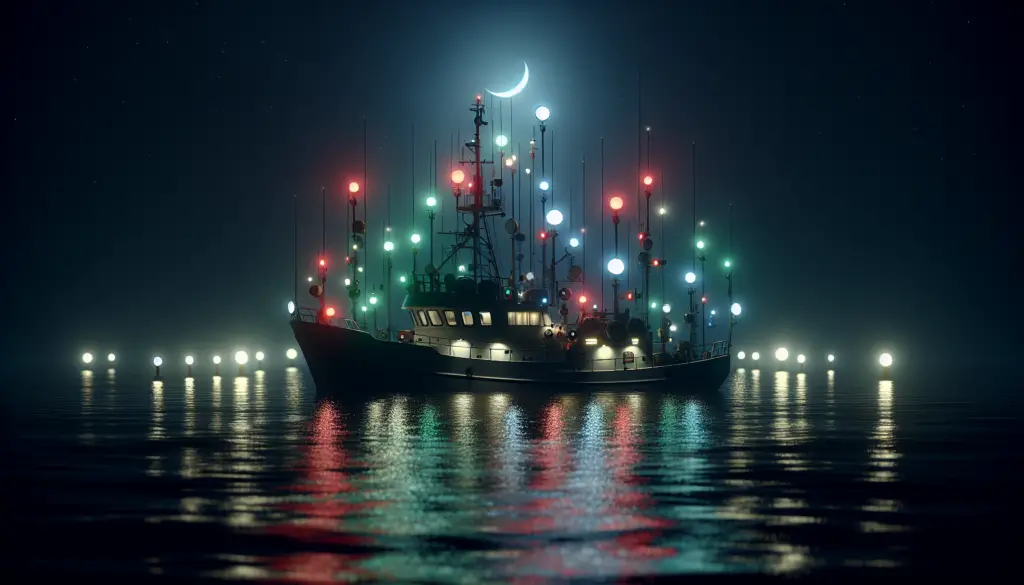
Understanding the Importance of Boat Navigation Lights
Relinquish your land legs as we soar into the stellar world of boat navigation lights. Much like how stars guide curious voyagers across the vast expanse of the night sky, boat navigation lights serve a crucial role in leading boats across the cerulean stretches of water bodies, painting safety strokes in the otherwise featureless landscape.
Role in ensuring safety and preventing accidents
Yet, their importance bursts far beyond aspects of mere aesthetic charm. Don’t mistake them for starlit ornamentation; these lights shoulder the hefty responsibility of safety and accident prevention. At night, when the earth smothers visibility under its pitch-dark blanket, well-placed navigation lights play hide and seek with potential hazards, allowing you to navigate seamlessly.
Importance in conveying the boat’s position, motion and dimensions
But wait, the magic doesn’t end here. They are the Morse code of the sea. They converse in a silent, luminescent language, conveying vital information about your boat’s position, motion and dimensions to fellow seafarers. With these lights glistening on the water, your vessel broadcasts an open dialogue with the surrounding marine traffic, reducing miscommunication and ensuring coexistence.
Legal requirements and regulations
In addition to their practical and safety roles, these twinkling guides are also bound by the steel threads of legislation. Understanding this legal framework is crucial. After all, you don’t want to be caught sailing with faulty or incorrect lights, which could leave you with more than just a taste of salt in your mouth.
Overview of Different Types of Boat Navigation Lights
As we delve deeper into this topic, you’ll unveil that navigation lights, like artists’ brushes, are unique and serve specific purposes. Here’s a glimpse of this diverse multitude of lights.
Bow lights: green and red
On the bow of your boat, you will find two lights, one green and one red – reminiscent of the sparkling Christmas lights. These bow lights outline the head of your boat and are clearly visible from the front and the sides.
Stern light: white
Casting a white sheen over the stern, the stern light is a radiant beacon announcing your heading to other vessels behind you, ensuring they maintain a safe distance.
Masthead light: white
Speaking volumes about your boat’s size and nature, the white masthead light, high atop the mast, is a commanding lighthouse, offering a view from just about every angle.
Anchor light: white
The humble anchor light, another white gem, is left on when the boat is stationary, singing a lullaby of tranquility to the passing vessels.
Sidelights: red and green
Sidelights, garbed in red and green, project to either side of your boat. Their radiance extends from bow to beam, clearly outlining your direction and orientation to other navigators.
Towing lights: yellow
Yellow-tinted towing lights, worn by boats hauling other vessels, convey a message of caution, like the flash of a traffic light at a busy crossroad.
All-round lights: white
Versatile all-round lights, flourishing in sparkling white, sweep an impressive 360° view, illuminating your vessel like a celestial body against the dark water canvas.
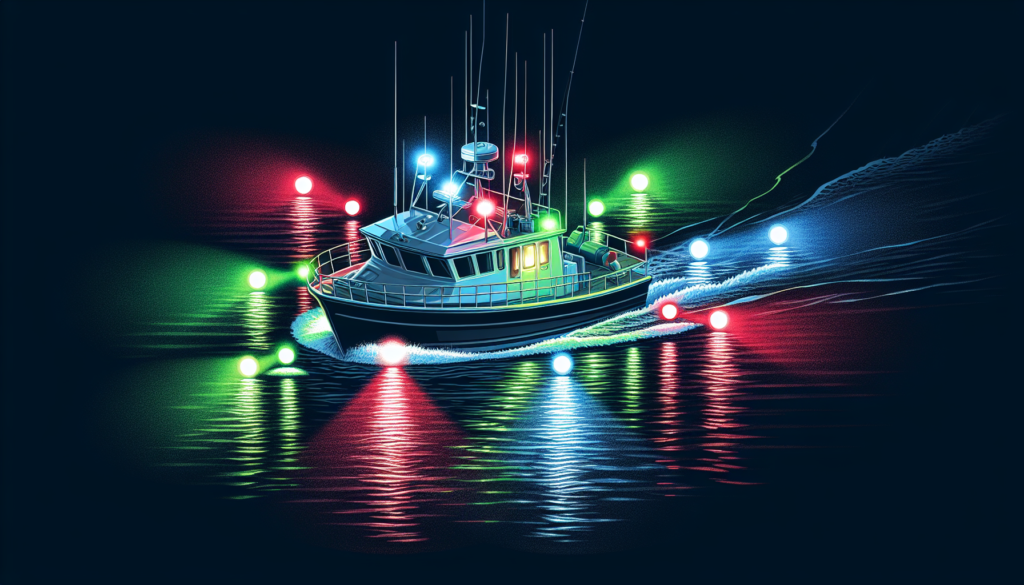
Placement and Visibility of Boat Navigation Lights
These lights, like pearls secured in their frustratingly specific slots in a necklace, are strategically placed to serve effectively in their roles. Their visibility is just as crucial as the light they cast.
Positioning of lights on different types of boats
Each type of boat, like dancers in a grand ballet, has its choreography. They have defined positions for their navigation lights designed to provide visibility and safety.
Visible distance and degrees of illumination
Not all lights bear the same strength. Some shine across vast distances; others boast wider degrees of illumination. Understanding these nuances helps you better judge your own and other boats’ movements.
Factors affecting visibility
Remember, visibility isn’t just a measure of the lights themselves. External conditions such as weather, sea conditions, and light pollution can dramatically impact their effectiveness.
Understanding the Colours of Navigation Lights and Their Significance
Unravel the fascinating significance of the colours in navigation lights, like decoding the mysteries locked in coded letters of a pirate’s map.
Red (Port) Light
The red light on the port side of your boat whispers the secrets of your vessel’s orientation, signifying to others that they are viewing your boat’s left side.
Green (Starboard) Light
On the flip side, if other boats see the green light on your starboard, they are aware that they’re looking at your right side.
White (Stern) Light
A white light stationed at the stern unveils the path of your majestic progress from behind.
Understanding colour combinations and what they indicate
The intricate combinations and arrangements of these colours communicate potential movement, direction, and your boat’s nature, much like an illuminated, moving chess board of marine navigation.
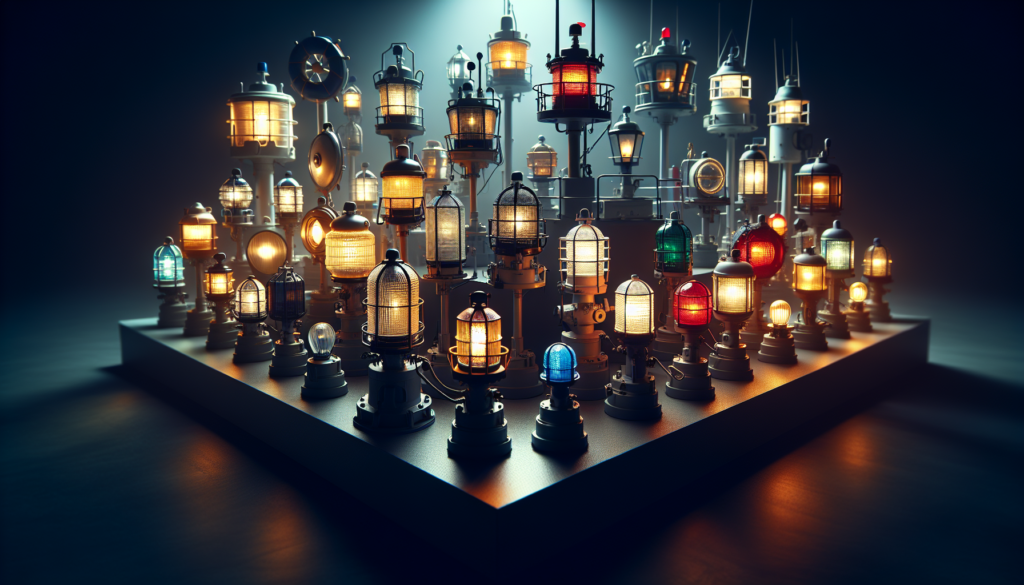
Reading and Interpreting Boat Lights at Night
Like a nocturnal creature attuned to the mysteries of the night, being able to accurately interpret boat lights at night is crucial for safe and smooth sailing.
Estimating the boat’s direction
The visible lights and their colour can help you discern the direction the boat is facing or heading, thus enabling you to navigate more confidently.
Identifying the type of vessel
The type of vessel on the inky canvas can often be revealed, solely by the arrangement and disposition of their lights.
Predicting the boat’s movement
Understanding the displayed lights helps you predict the boat’s potential movement, allowing you to respond proactively rather than reactively.
Decoding the Flashing Patterns of Boat Navigation Lights
Navigation lights can communicate through flickers and glows. Embrace their silent language and learn to decode the flashing patterns they paint in the dark.
Single-flashing light
A single-flashing light is similar to a heartbeat, a rhythmic pulse indicating that a seafaring companion is nearby.
Double-flashing light
The double-flashing light is a more urgent call, a blinking caution signal that could indicate a more complex situation.
Long-flashing light
A long-flashing light, holds an extended conversation across waters and can denote various situational aspects.
Interpreting different flash sequences
Mastering the language of lights conveyed through flash sequences can drastically improve your nighttime navigation skills.
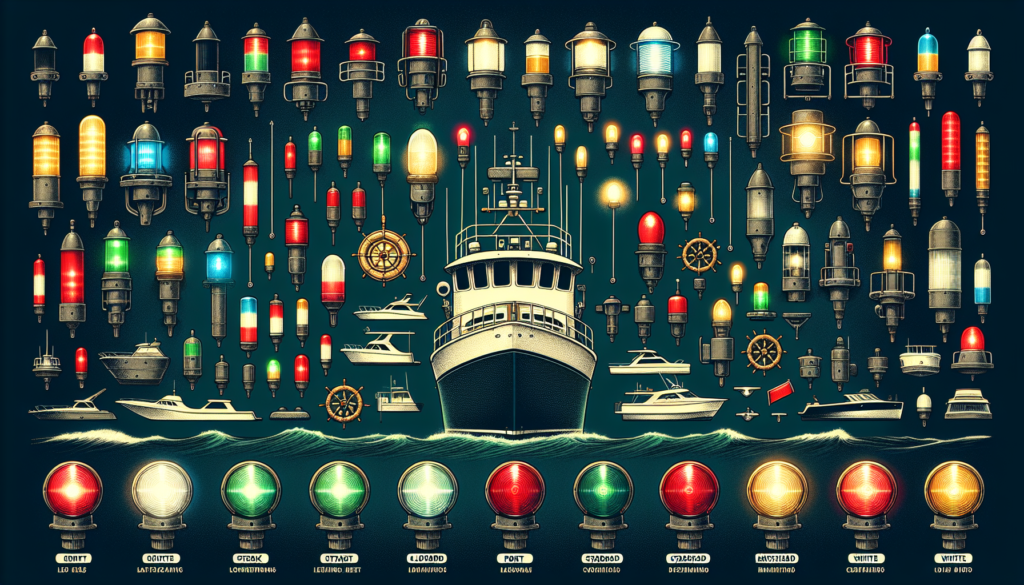
Special Lighting and Markings for Different Types of Boats
Each boat type bears its unique hallmark of lighting. Embrace this kaleidoscope and widen your understanding of how each boat sings its luminous symphony.
Fishing vessels
Fishing vessels engrave their presence with distinctive light configurations, ensuring you steer clear of their activity.
Sailing vessels
Sailing vessels, gracefully harnessing the wind’s power, demonstrate an entirely different set of lights, akin to a siren’s lyrical serenade.
Towing vessels
Heaving with the exertion of tows, towing vessels blink with specific lights, like a cautionary tale glowing in the darkness.
Vessels not under command or restricted in ability to maneuver
Vessels not under command or with limited maneuverability tattoo the night sky with unique patterns, serving as bright reminders of their situation.
Dredging or underwater operations
For those nipping at the sea bed, unique navigation lights share a peek into their undersea operations.
Rules for small boat and vessels under oars
Life isn’t dim for smaller vessels and those under oars, as their own rules light their way, proving that size doesn’t diminish importance.
The Role of Light Sectors in Marine Navigation
Sectors of light guide you in navigating through this marine tapestry of navigation lights, each sector leading you safely through each stitch.
Understanding light sectors
Sinuous and complex as mysteries of the ocean, light sectors cradle vast knowledge within their luminous arcs. Unravel their essence for a commanding control over sailing.
Reading a light sector diagram
Describing the landscape of lights, is a naval chart not unlike treasured parchments of old. Master the art of reading these fascinating diagrams to navigate like a true seafarer.
Interpreting different colours in a light sector
The appearance of different colours within each sector is as vibrant as a chameleon’s skin, every shade whispering different aspects of marine navigation. Explore this spectrum and let it illuminate your understanding even further.
Maintenance and Troubleshooting of Boat Navigation Lights
Ensuring that these guiding stars continuously shine bright requires maintenance and care. Steep yourself in the nuances of maintaining these crucial elements of your journey.
Choosing the right bulb for your boat
Multiple factors influence the choice of the right bulb for your boat – a subtle art that balances performance, longevity, and efficiency.
Replacing a navigation light bulb
Like changing a torch’s weary batteries before an adventurous night expedition, replacing a bulb in time keeps your navigation light proficient.
Troubleshooting common issues
Acknowledging that even the brightest stars may flicker, troubleshooting common issues can bring your navigation lights back to their shining glory.
Maintaining and cleaning navigation lights
Consistent maintenance and cleaning ensure that your navigation lights don’t fade into obscurity but continue to beam radiantly.
Learning and Using International Regulations for Preventing Collisions at Sea (COLREGs)
Connect your knowledge of navigation lights with the broader framework of the International Regulations for Preventing Collisions at Sea or COLREGs for short. This comprehensive guidebook offers a wealth of information on the practice of safe and efficient sailing.
Understanding COLREGs and its importance
COLREGs are like the Constitution of the sea – the defining manual of rules and regulations that govern the way boats move about in bodies of water.
COLREGs concerning navigation lights
According to COLREGS, every blinking, flashing and constant-on light on your boat has a regulatory purpose. Understanding these creates a safer atmosphere for everyone on the water.
Practical application of COLREGs while sailing
Practical application of COLREGs promotes harmonious coexistence on the high seas, much like well-rehearsed musicians in an orchestra, each playing their part to create a flawless performance.
So, shipmates, as we lower the anchor on this journey of understanding boat navigation lights, you are better equipped to navigate your vessel. Let these lights be your companions guiding you through the darkest nights, ensuring you sail in harmony with your fellow seafarers in the grand symphony of the sea.

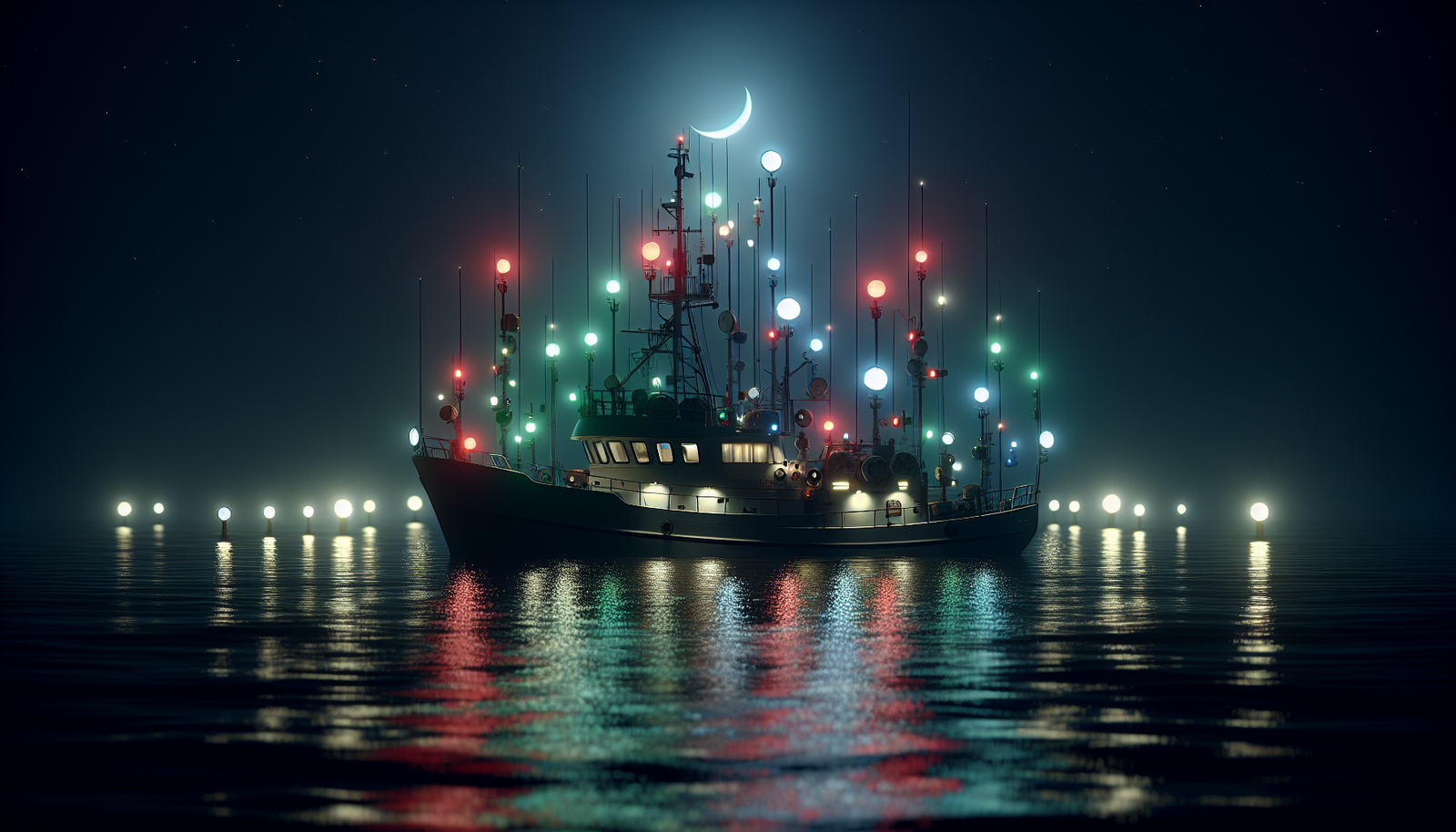
[…] buoyage system stands as your silent, reliable, sea partner. The “Beginner’s Guide to understanding buoyage systems” tears down the complex walls surrounding these sea markers and charts a course that even […]